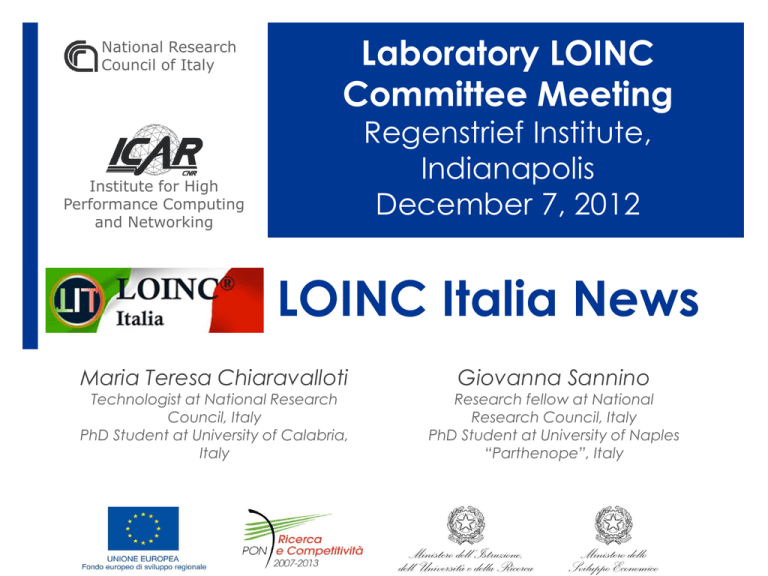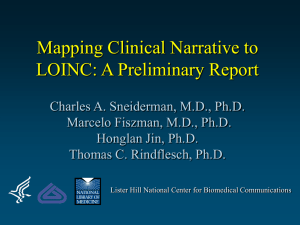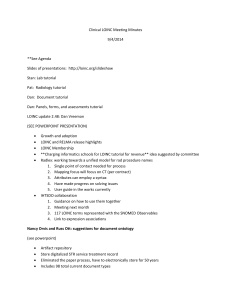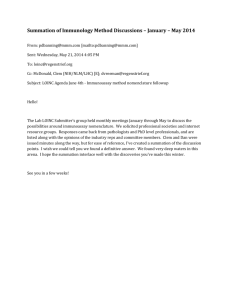Handout - LOINC Italy - 2012 12
advertisement

National Research Council of Italy Laboratory LOINC Committee Meeting Regenstrief Institute, Indianapolis December 7, 2012 Institute for High Performance Computing and Networking LOINC Italia News Maria Teresa Chiaravalloti Technologist at National Research Council, Italy PhD Student at University of Calabria, Italy Giovanna Sannino Research fellow at National Research Council, Italy PhD Student at University of Naples “Parthenope”, Italy Where we left last time… National Research Council of Italy Institute for High Performance Computing and Networking Mapping results: an example 2376 local lab tests (Laboratorio Lamberti) National Research Council of Italy 89% mapped VS 11% unmapped Institute for High Performance Computing and Networking What we understood It is strictly necessary a standardized mapping procedure/guidelines The chance to look at what other labs have done is a key factor in mapping success LOINC Mapping Repository and RELMA “Community Edition” Project National Research Council of Italy Institute for High Performance Computing and Networking Where we left last time… National Research Council of Italy Institute for High Performance Computing and Networking Governamental adoption of LOINC LOINC is one of the standardized vocabulary recommended for identifying single items in clinical report documents National Research Council of Italy Institute for High Performance Computing and Networking Part translation updates LOINC 2.34 RELMA 5.0 (Dec 2010) LOINC 2.36 RELMA 5.3 (Jun 2011) LOINC 2.37 RELMA 5.4 (Dec 2011) LOINC 2.41 RELMA 5.9 (Dec 2012) Translated atomic parts 11,748 11,748 12,924 19,275 Synonyms 3,341 6,026 7,092 9,092 Translated full term names 43,152 43,720 45,813 ? + Clinical Parts National Research Council of Italy Institute for High Performance Computing and Networking Mobile Health Monitoring Systems Aims: This research activity aims at designing and realizing an intelligent mobile system for clinical care and remote patient monitoring, in particular for heart monitoring of patients with chronic heart diseases. Monitor parameters is not enough: Example: a system monitors Heart rate and Heart rate variability; if (HR >= 120) alarm If the person under monitoring is running? Intelligent context awareness National Research Council of Italy Institute for High Performance Computing and Networking Mobile Health Monitoring Systems Idea: Proposed approach aims at solving some m-Health open issues about intrusiveness, technological limits, reliability, interoperability and security in order to guarantee : Non-intrusive data capture by using wearable monitoring devices Intelligent data analysis for Medical aims or healthy LifeStyle Pervasive data transfer and access (e.g. Electronic Health Record) Interoperability between health services and devices Reliability in communications Security in terms of privacy and data Integrity National Research Council of Italy Institute for High Performance Computing and Networking Mobile Health Monitoring Systems Results: A prototype system has been designed and realized in order to: Guarantee an intelligent data analysis in terms of reliability Assure a correct monitoring and warning system for doctors and for patients reducing false positive alarms The prototype is for Android Tablets and Smartphones and for PC Desktop Windows based. The proposed approach consists in: Correlation of biomedical parameters with patient’s context-aware information: Biomedical information: HR, HRV, SpO2, Glycemia, Body Temperature, Respiratory Rate, etc. Physical activity: Posture, Movements, etc. Use of knowledge technologies to build proper applications National Research Council of Italy e.g. Decision Support Systems Institute for High Performance Computing and Networking Mobile Health Monitoring Systems More biomedical sensors are integrated in our system, like: Zephyr BioHarness: a physiological monitoring system. The subject wears a Smart Fabric chest strap or shirt which incorporates sensors to monitor heart ECG signals, and respiration rate. Attached to the strap is the BioHarness Module. This contains a temperature sensor and a 3-axis accelerometer for monitoring attitude (subject posture) and activity (acceleration). Alive ECG Monitor: a small device aimed at monitoring the user's ECG. The ECG signal can be stored in an SD memory card placed on the device and/or transmitted via a Bluetooth connection to a mobile phone, PDA, or PC for real-time display, recording and analysis. It is a wearable system suitable for the screening, diagnosis and management of cardiac chronic diseases. It is also able to monitor movements and physical activities performed by the user by means of an embedded accelerometer sensor. National Research Council of Italy Institute for High Performance Computing and Networking Mobile Health Monitoring Systems The system was tested on: Asus Eee Pad Transformer Prime Android 4.0.3 Samsung Galaxy “gio” Android 2.3 PC Desktop Windows XP National Research Council of Italy Institute for High Performance Computing and Networking Mobile Health Monitoring Systems What LOINC can do for us: Terminology standard: Communication with Electronic Health Record Systems (EHR) LOINC coding system is used to identify all monitored parameters Definition of Rules (?m http://mH#heartRate ?hr), greaterThan(?hr,100) -> newInstance(?abn, http://mH#abnormalCondition), (?abn http://mH#conditionType 'Tachycardia'^^xsd:string), (?abn http://mHealthOnto#dueTo ?m) ] (?m http://mH#8867-4 ?hr), greaterThan(?hr,100) -> newInstance(?abn, http://mH#abnormalCondition), (?abn http://mH#conditionType 'Tachycardia'^^xsd:string), (?abn http://mHealthOnto#dueTo ?m) ] National Research Council of Italy Institute for High Performance Computing and Networking Mobile Health Monitoring Systems What we can do for LOINC Contribute to upgrade the database with new codes related to parameters detected by wearable sensors “Sagittal plane body position” : LOINC number 72282-7 National Research Council of Italy Institute for High Performance Computing and Networking Conclusions and future work We would like to suggest to start thinking about the need of a «translation control». Could be challenging BUT it is LOINC content that goes all over the world LOINC is part of a third stage of the InFSE project (started July 1st 2012) LOINC tutorial LOINC online helpdesk Clinical LOINC, especially Tumor Registry class, to be used in a recently approved project by Pharmacy Department of the University of Calabria National Research Council of Italy Institute for High Performance Computing and Networking National Research Council of Italy Laboratory LOINC Committee Meeting Regenstrief Institute, Indianapolis December 7, 2012 Institute for High Performance Computing and Networking Thank you for your attention! Maria Teresa Chiaravalloti chiaravalloti@icar.cnr.it Giovanna Sannino giovanna.sannino@na.icar.cnr.it











